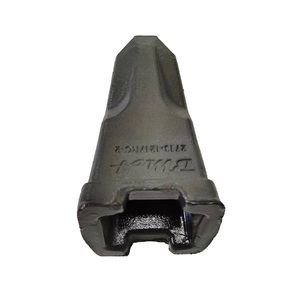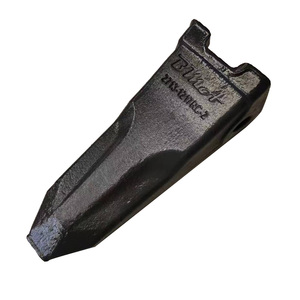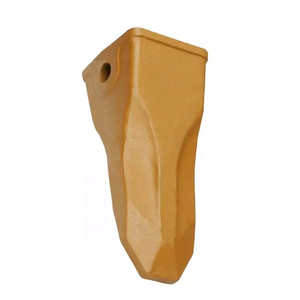
All categories
Featured selections
Trade Assurance
Buyer Central
Help Center
Get the app
Become a supplier

(993 products available)

































A backhoe loader has two buckets or arms. An ADC (Abrasion-Resistant Cast Iron) is commonly used for the case backhoe bucket teeth, which is a robust material. However, this material offers limited reparability, and once it breaks, it must be entirely replaced. A backhoe digger has different types of bucket teeth, such as:
Abrasion (ADC)
A backhoe bucket tooth is an essential part of the digging and loading mechanism of earth-moving machines. Its primary purpose is to penetrate the ground with ease.
Load (LDC)
Load bucket teeth are typically wider and flatter teeth designed to increase bucket capacity and facilitate efficient loading operations.
Concentrated (CDC)
Concentrated bucket teeth are generally tapered teeth designed to provide enhanced penetration capability when digging in hard or compacted soil conditions.
Dura (DAC)
Dura bucket teeth are often made from a durable, abrasion-resistant material and are designed to provide extended wear life and maintain performance in demanding applications.
Penetration (PDC)
PDC teeth are high-performance teeth designed to provide superior penetration in tough digging conditions, such as rocky or heavily compacted soils.
Multi-use (GDC)
General duty bucket teeth are versatile teeth designed for use in a wide range of moderate digging applications.
Sharp (S)
Sharp bucket teeth are designed to provide optimal digging performance by offering excellent soil penetration and reduced dragging forces.
Africa has a diverse range of backhoe bucket tooth applications. For example, in the mining sector, where buck teeth are used for loading, tough and resilient materials that can withstand extensive use and abuse are required. However, in city construction projects and infrastructure development, where precision loading and limited intermingling are required, versatile teeth that offer good accuracy and control are used. Additionally, in agricultural sectors, teeth that can effectively and delicately load without damaging crops are used.
It is essential for business buyers to understand the different applications and materials of bucket teeth to select the most compatible and functional ones for their equipment and projects.
Structural integrity
The welds on the bucket teeth should be consistent without any breaks or gaps. This creates a strong joint that connects two materials or components, ensuring they stay together and don't come apart. Such strong, even welds enhance the durability and strength of the bucket teeth, allowing them to perform well over time without easily breaking or wearing out.
Fit and finish
This refers to how well bucket teeth for case backhoe perform their job and how nicely they are made. When people say something has a great 'fit and finish,' they mean it works very well and looks good made. If the bucket teeth fit perfect and have a smooth finish, they dig dirt better and last longer.
Play
This means the space or movement between parts like a case backhoe bucket and its teeth. If things fit well, there won't be much space or movement - just a tiny bit called allowable play. Not much play makes connections stronger and prevents wearing out fast.
Maintaining case backhoe bucket teeth is crucial to ensuring they remain efficient, durable, and safe. Here are some practical tips for keeping bucket teeth in good condition:
Regular Inspection:
Users should frequently examine the bucket teeth for wear, damage, cracks, or other issues. Looking for problems quickly helps people fix things before they become bigger issues.
Replace Tooth:
As wear happens, it's essential to replace only the worn teeth instead of replacing the whole bucket. Changing just the ones that have worn down saves money and maintains even performance for the whole digging setup.
Repair Badly Worn Teeth:
If some teeth get really worn, consider welding on extra material instead of buying new ones. Welding builds the tooth back up, extending its life, but might still be cheaper than getting a brand-new tooth.
Backhoe bucket teeth are crucial to the operation of backhoes in various industries. They are utilized in many machinery sectors such as construction, mining, agriculture, and landscaping.
Construction Industry
In the construction industry, case backhoe bucket teeth are used for trenching, foundation digging, and backfill tasks. The pointed teeth are ideal for digging foundations, which ensures stability. The tapered design also makes them suitable for creating drainage and utility trenches. Backhoe bucket teeth can also be used for excavation projects like digging for pools or large pits.
Mining Operations
Backhoe bucket teeth are used extensively in the mining industry. In surface mining operations, case backhoe bucket teeth are used to remove overburden. They are also used for coal and ore extraction. The teeth can also be used to clear land for new mining operations.
Agriculture
In the agriculture industry, backhoe bucket teeth are used for plantation and irrigation. They are also used for land leveling and clearing. Furthermore, backhoe teeth are used to make farm infrastructure like digging wells or constructing storages.
Landscaping
In the landscaping industry, case backhoe bucket teeth are used for digging, planting, and contouring. The teeth are ideal for installing features like ponds and terraces. Furthermore, they can be used to clear debris and excavate for planting trees and shrubs.
When choosing the case backhoe bucket teeth, it is important to select the ones compatible with the bucket and the operational needs.
Compatibility with the bucket
The backhoe bucket teeth should be compatible with the bucket they are intended for. This includes matching the size, shape, and attachment mechanism of the teeth to ensure a proper fit and function. Additionally, it's important to consider the material of the backhoe bucket teeth and its compatibility with the backhoe bucket's construction.
Work environment
Consider the work environment in which the backhoe will be used. Factors such as soil composition, temperature extremes, moisture levels, and exposure to chemicals or abrasion should be taken into account when selecting bucket teeth. Choose teeth that are suitable for your specific work environment to ensure optimal performance and durability.
Wear resistance
Wear resistance is crucial for backhoe bucket teeth, as they are subjected to constant abrasion during digging and excavation tasks. Opt for teeth made from high-quality materials with excellent wear resistance to prolong their lifespan and maintain cutting efficiency. Premium-grade steel alloys and surface hardening treatments can significantly enhance the wear resistance of bucket teeth.
Attachment method
Focus on the attachment method used for the bucket teeth. Common attachment methods include pinned or clamped teeth. Consider the advantages and disadvantages of each attachment method and choose the one that best suits your needs. For example, pinned teeth provide a secure and reliable attachment, while clamped teeth offer easier installation and replacement.
Q1: How can users ensure proper fitting of new CASE backhoe bucket teeth?
A1: Before ordering replacements, examine the worn-out teeth and take precise metrics of their dimensions. Select new teeth that match the old ones' shapes and sizes. Adjust the bucket's weld areas to enhance the fit. Utilize identical pin-and-socket locking systems for consistent fastening.
Q2: Why do users need bucket teeth for a backhoe?
A2: The reasons users need bucket teeth for a backhoe have already been discussed in the text above. However, summary reasons include improving the efficiency and effectiveness of the backhoe, boosting the lifespan of the backhoe buckets, etc.
Q3: How often should users replace their CASE backhoe bucket teeth?
A3: Consider replacing the teeth when their wear level compromises performance. Set a periodic inspection routine. Replace them based on visual assessments rather than a fixed schedule to save costs while enhancing efficiency.